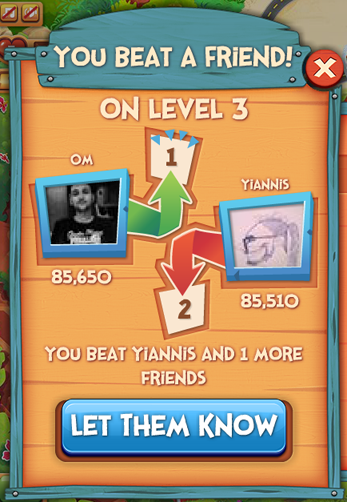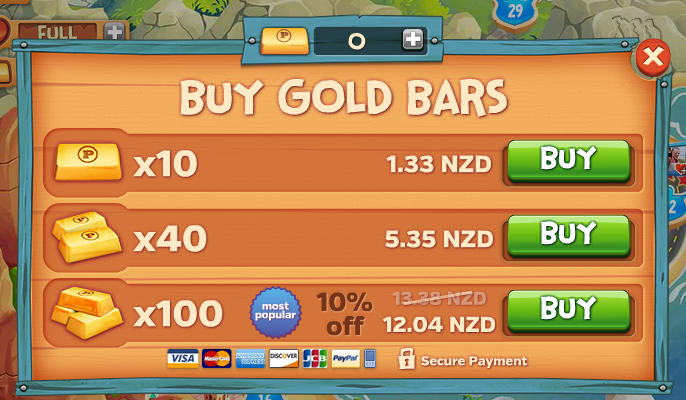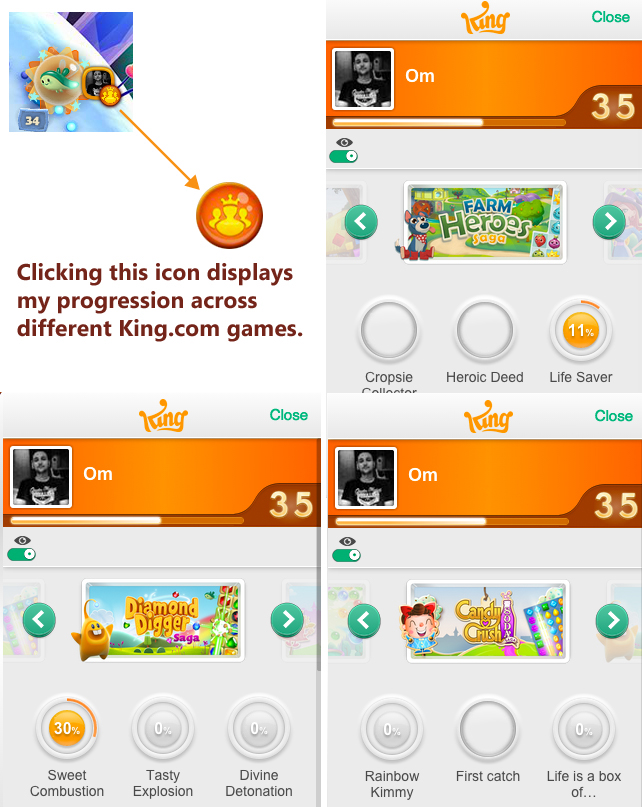I regularly publish articles on GAMASUTRA analysing UX design of games and market trends.
part of comptetion and benchmark research.

Not a one trick pony:
When it comes to 'Match 3' experience everybody agrees 'King.com' is the undisputed King (so far) with it's titles reigning the app store for over 2 years now. There were speculations some time ago - is King going to be a one trick pony with 'Candy Crush Saga's Success?
I think that question has been settled and critiques silenced with a repeat feat of 'Candy Crush Soda Saga' and it's other titles (Farm Heroes, Pet Rescue, Diamond Digger) holding on to top grossing list without fail. Match 3 genre has consistently built fortunes of many a companies and has great following among casual gamers. We are seeing all sorts of fun and innovative avatars flooding the market.
This is a UX take on what continuously makes 'King' titles so sticky and experience design that resonate so strongly with players deep down, with an attempt to breakdown where 'Match 3 Genre' is heading and potentiality where to seek inspiration from.
Most of you must have played many existing titles on FB and Appstore, I am going to start with the latest and least known title of them all.
Pepper Panic Saga.. face of things to come?
It's still just available on Facebook as of now, and as per King's known pipeline:
Royalgames.com -> Facebook -> App stores
It's at stage 2 Facebook as of now.
The game probably will have to hit internal benchmarks (user base, engagement, retention, monetisation and other KPIs) before it will be released on the app store. A solid pipeline of vetting out flaws, adjusting game mechanics, improvising social hooks, tweaking monetisation before it is released for mobile devices (iOS, Google Play, Windows etc).
King has the mother of all soft launch processes in place, while most other developers have to make do with limited release on one or two app stores. King has a more efficient and long term pipeline with the ability to rapidly push updates and tweaks, respond to trends on facebook without player needing to update or go through content approval (in case of mobile devices and app stores), which makes facebook a formidable platform. By the time it's released on app stores, the game would have already been tested with large demographics of casual players on King's hosting site and facebook players who are ranked high in regards to both retention and monetisation as far metrics are concerned.
The Gameplay:
Most games struggle to make this connection with their target demographics, and easily loose the plot, Game devs, end up designing and building a narrative/story that resonates very strongly with their own imagination, but that does not mean it will resonate well with players.This can be easily tested.
1) You will be surprised usability studies of interface and narration of your game done at early stages on casual unbiased player will reveal the experience you design for players is not always how they perceive it.
Pepper Panic has that Southern look with an art style and music that give it a distinct identity. The tile elements are now replaced with Peppers of varied colours creating explosive and flaming pyrotechnic effects one can expect from incredibly hot peppers - a far cry from sugary, sweet confectionary themes that a host of current match 3 games employ. But surprisingly the peppers pack quiet a punch once you start playing the game, and for some reason I keep making comparisons with vibrancy of 'Guacamelee'.
3) Be careful which existing mental model are you feeding, for example New zombie game releases will be inadvertently compared to popularity & familiarity of series like "The Walking Dead".
Criminal case reminds player of all the forensic series and movies they have watched glued to the tube season after season. 'Pretty Simple' (the developers) kept it simple by sticking to what players could relate to, and not over complicating the premise.

Effectively the dynamics of a collapsible match 3 (Bubble Witch, Pet Rescue, Papa Pear) and tile matching (CCS, CCS Soda) Match 3, has been rolled in to a new dynamics: "Evolution"
But wait, there's more!
We are witnessing a Match 3 game (a descendant of Candy Crush era) on steroids! The pace of gameplay makes Candy Crush feel sluggish in comparison. The things that will stand out from a UX perspective if you have been avidly playing Match 3 games are:
1) Increase in ease and frequency of making enchanting and stimulating power-ups.
2) Multipliers and chain reactions that result in explosive rich and graphical experiences.
3) On average large frequency of moves made by the player results in multiplied 3 moves (at least) made by the game itself (in term of creating additional boosts or clearing the board)!
4) Reciprocated moves that work to players advantage (this is quiet apparent Candy crush soda saga as well). This is a far cry from the hint system (like most match-three games, which will suggest a match if you take too long to make a move. These suggestions usually are not the best matches available as a result you come to distrust the hint system).
5) Distinctive and differentiated climax mode from peak moments adds a special touch to victory celebration.

6) The above factors result in comparatively shorter but satisfying gameplay due to multiple peak moments ,which is quintessential for mobile gaming audiences, due to known decrease in user attention span, a rising trend year after year.
7) Failure scenario: Level difficulties dynamically adjust over time. It's quiet apparent if you are stuck at a level and have failed for 4-5 times in a single play session, all you have to do is log out and when you come back next time (next day or after few hours), the difficulty seems to go down and you manage to progress with ease. Luck? Skill? or an AI system accounting your failed attempts and easing the difficulty for you to progress and not give up.
UX Take: 3 major things that standout and reflect on where this genre is heading:
Fast paced, creation of multiple peak moments.
Frequency of reciprocated moves, that reduce user input.
Failure scenario handling
Frequency of reciprocated moves, that reduce user input.
Failure scenario handling
Why do these above insights matter as far as User Experience is concerned?
"Experience is a temporal component, spreading over time"
We can easily apply Gestalt characteristics of summarised experience to them. Simply put whenever people experience any event (a game session in our case) their summary of the experience is not just measured by all the components of the evaluated events or entire duration, but tends to focus on only a few features (gestalt characteristics). These defining features include the rate at which the transient state components of the experience become more or less pleasant over its duration, and the intensity of the state at key instances:
In particular the most intense (peak) and the final (end) moments.
The graphs below are simplified visual representation of a players' experience in terms of Gestalt characteristics.When our mind recalls or makes evaluation of an experience or past event, it builds a base of snapshots of what transpired which are generally the intensity of pleasure or pain experienced at peak and end points.

Graph 1: A simple experience profile of a play session with a single peak moment which could also overlap with game changing moment (as in a car racing game where you are neck to neck with your rival). And based on if you overtake, you could end up wining or loosing triggering the end moment experience - victory or failure. In this case the peak and end moments greatly overlap. the players experience will be coloured by the peak moment.

Graph 2 : A play session that creates multiple peak intensity moments for the player over time, creating more memorable and defining moments. The collective effect of these high intensity peak moments have the potential to negate the effect of failing or clearing a level.

Graph 3 : An experience profile with highly intense peak moments. Imagine riding a roller coaster which has several such moments; and a final drop through a water slide. The time duration of the rides can be quiet small, but the adrenaline rush created at peak moments can completely colour the evaluation of a riders experience.
All of the experience profiles above and more combinations executed well can create player engagement. But Graph 2 resonates strongly with what we are experiencing in new crop of Match 3 genre.
Players have enough motivation to like the game (due to multiple peak moments) which reduces the pain of failure, colouring players experience. Combine this with point 6 "Failure scenario handling" where difficulties of failed levels dynamically reduce over time helps in creating a more engaging and retentive experience.
Social:
"Any design pattern done over time becomes white noise that players learn to ignore. Constant innovation & experimentation is the only key to keep players engaged."
Much is known about the social aspect. Sending & receiving gifts, boosters passing gates, social leaderboards - these have been cloned and copied by so many games that players have learnt to turn a blind eye.
1) King has been coming up with new UX features that if not persuasive are certainly delightful and make users curious. Like incorporating, gifting and profiling buttons directly on friends profile images on the map.

2) Personalised social sharing, wherein you can personalise your share messages, differentiating them from pre-defined spamming messages.

UX Tip : I feel the map in King games is a visualised leaderboard showing your position relative to friends. It would be good to have some kind of proximity animation, triggered when you are about to surpass your friends on the map and it can grow stronger as you get closer to overtaking them.
Random rewarding of gold bars when you surpass a friend(s) will subconsciously make player put a target on his friends back, and will create a secondary objective of trying to catch up and overtake.
Monetisation: Choice Simplification
The shop design in King games aims at simplifying the choice for the user and do not bombard the player with interstitials and promotions unlike so many other games. King promotes an option of 3 packs only to NPU's, that also with low price points pushing for conversion from non-paid to paid rather than trying to make an up sell. It's not a one-size-fits-all approach.
Understanding a NPUs resistance to spend money, it is assumed that NPUs must be presented with simple choice of 3 packs (which aids decision making by reducing clutter and confusion).

When I started playing the game initially, the first time I needed to buy gold bars I was presented with a screen offering 5 price points - not 3. I declined the offer. Since then, the game only shows me 3 price points (it's been 4 months now) marking me as a NPU and simplifying the choice for me by offering only 3 price points.
This behaviour changes to presenting 5 price points once you have made a purchase (it's apparent in other games too), clearly marking you as a spender and encouraging you to buy higher volumes which further validates that King applies different strategies for NPUs and PUs that reflect strongly in the UI behaviour.
Choice simplification is further carried over to booster packs as well, offering only 2 options where in the second one outweighs the first as with the shop.

The offer allows the player to purchase up to 20 such bundles.
But I think while the attempt to give user a choice of personalising purchase is really commendable it is still lacking, the design itself could be further modified to make it more impactful.This model allows the user to purchase multiple instances of the super bundle but gives no control over changing the actual value of it,s content.
Gold Bar Consistency:
As I have pointed out in my previous post, King uses gold bars as a standard currency across all it's games, irrespective of their theme. Other than the fact that it is a real-world precious object which has a universal appeal, most of the King game players are from a common pool of Match 3 genre (If you play CCS you might also be playing Farm Heroes, CCS Soda, Pet Rescue).
What I am getting at is that this audience is already primed for purchase, since chances are they bought "Gold Bars" in one of King's Match 3 games and they know it's value. Seeing a familiar currency primes the user and softens their stance to buy again.
UX Tip : I feel King has a very unique advantage because of this consistency, with increased improvement in it's player profiling system as witnessed below

With it's new progression system, King knows how many of it's titles I play regularly and definitely my HC status, level status etc.
Is it then possible for King to have a universal currency (which it already has in terms of consistent gold bars) and use it for cross promotion of it's games? Offering discounts not just in one game but synced across it's entire product range?
Hypothetical model - Volume discounts across products!
Imagine a scenario where I am a player who plays 3 of king's titles Farm Rescue Saga, Candy Crush Soda and Diamond Digger Saga at different intervals of time. The reason I might have stopped playing Diamond Digger & Candy Crush Soda, or might not be making much progress across these titles is because my HC has depleted impacting my ability to buy boosters or +5 moves.
So I am grinding across Farm Heroes Saga and King knowing my HC status and progression status across it's other games (Diamond digger & CCS Soda), throws me synchronised discount offers


These offers give player an additional motivation to make a purchase (provided he is invested in multiple titles which the stats will reveal). His purchase of this offer empowers him to play and progress across more then one title (100 bars in Farm Heroes and additional 30 in Diamond Digger, or any other title relevant to the player).
From King's perspective these volume discounts spread across 2 of it's properties, provide better burn rates - 100 gold bars in one title will be spent faster then 130 gold bars in the same title, reducing the time gap for next purchase point considerably. It also cross promotes King's game effectively rallying player to go and play the other title.
The same synchronised behaviour can be applied to achievements or by creating common rewards that can be consumed across various King titles bordering on VIP systems so much in vogue today. In fact King can build an empire based on networked cross linked games due to unique consistency of it's currency and Match 3 titles.

